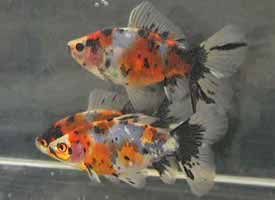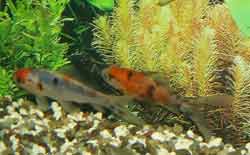
A shubunkin (meaning 'red brocade') is a type of single-tailed goldfish with calico colors: a combination of orange, white, black, red, and blue markings. They are hardy, able swimmers with bright colors.
In China, the shubunkin is called Chuwen-chin.
The English name in Hong Kong is Variegated Swallow Tail.
Japanese coined the name Shubunkin which means 'vermilion red dappled with different hues'.
The English name in Hong Kong is Variegated Swallow Tail.
Japanese coined the name Shubunkin which means 'vermilion red dappled with different hues'.
Some live for 15 years or so and the maximum documented age is 33 years.
The shubunkin has become a very popular pond fish since it is one of the toughest goldfish types.
It has a single tail, normal eyes, and no head growth.
The length of the body (without the tail) is 2 to 2-1/2 times the depth at the widest point.
Shubunkin are somewhat smaller than common goldfish. The maximum length is about 12 inches, though typically they do not grow larger than about 6 inches.
It has a single tail, normal eyes, and no head growth.
The length of the body (without the tail) is 2 to 2-1/2 times the depth at the widest point.
Shubunkin are somewhat smaller than common goldfish. The maximum length is about 12 inches, though typically they do not grow larger than about 6 inches.
The shubunkin has a slender body just like the common goldfish, but is different, because of it’s distinctly different colors - red, brown, orange and yellow colors combined with black spots - the so called calico colors.
Calico means there are three or more colors present.
They are almost always speckled or have a variegated pattern.
The ideal is a blue background with patches of red, orange, yellow, gray, white, black, and brown.
They are almost always speckled or have a variegated pattern.
The ideal is a blue background with patches of red, orange, yellow, gray, white, black, and brown.
The scales on a shubunkin are transparent. Shubunkin are nacreous which means the scales are transparent with an underlying opalescent sheen.
They are a bit smaller than common comets, growing up to about 15 cm long. Like all other goldfish, they are social, omnivorous, and can thrive in temperatures down to freezing.
They are a bit smaller than common comets, growing up to about 15 cm long. Like all other goldfish, they are social, omnivorous, and can thrive in temperatures down to freezing.
Shubunkin were developed in Japan around by 1900 by Mr. Akiyama.
The tail length was later improved in the U.S., resulting in a type of shubunkin called 'Japanese/American'..
The tail in this variety can be as long as or longer than the body and may be up to 12 inches.
The tail length was later improved in the U.S., resulting in a type of shubunkin called 'Japanese/American'..
The tail in this variety can be as long as or longer than the body and may be up to 12 inches.
These colors can found on the main body as well as on the fins and are displayed on a violet or silvery-blue background.
The blue coloration, which is very much sought after, will depend on the amount of melanin in the sub-epidermal layers. The color blue is rarer and can makes this type more valuable.
The blue coloration, which is very much sought after, will depend on the amount of melanin in the sub-epidermal layers. The color blue is rarer and can makes this type more valuable.
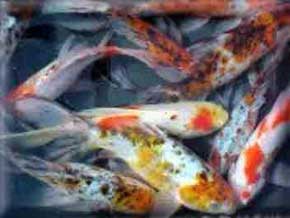
Between the World Wars, shubunkin were introduced to Great Britain and became very popular because they are hardy enough to withstand winter conditions outdoors. These early English fish had narrow, sharply pointed tail lobes with considerable variation in fin length. From these variable stocks, two sharply divergent lines were developed and refined over the last 70+ years, the London shubunkin and the Bristol Blue shubunkin.
The Japanese/American shubunkin is the ‘original’ and has a deeply forked caudal fin.
The fin has long narrow lobes that end in a point.
For a show fish, the caudal fin should be at least as long as the body of the fish.
The fin has long narrow lobes that end in a point.
For a show fish, the caudal fin should be at least as long as the body of the fish.
The London shubunkin has a much shorter caudal fin, usually around 25 percent of the body length.
The tail fin should be well rounded and moderately forked, and should not be more than 1-1/4 times the body depth. The length of the caudal (tail) fin should be no more than 1/3 as long as the body and must have rounded ends
The London type is much more common than the Bristol type and is usually what you will find. The London shubunkin has been bred to have shorter tail fins.
The tail fin should be well rounded and moderately forked, and should not be more than 1-1/4 times the body depth. The length of the caudal (tail) fin should be no more than 1/3 as long as the body and must have rounded ends
The London type is much more common than the Bristol type and is usually what you will find. The London shubunkin has been bred to have shorter tail fins.
The Bristol shubunkin is different from the two other types.
It has an enormous tail fin that is very wide, moderately forked with well rounded lobes.
As the Bristol shubunkin age, the wide lobes can collapse. Breeding is directed towards tail fins which are long, but are also strong and do not collapse or scissor as the fish matures. The standard calls for the this variety to be calico with at least 25% of the body being blue.
Bristol shubunkins are very hardy, and can become very tame. Some live for 15 years or so.
It has an enormous tail fin that is very wide, moderately forked with well rounded lobes.
As the Bristol shubunkin age, the wide lobes can collapse. Breeding is directed towards tail fins which are long, but are also strong and do not collapse or scissor as the fish matures. The standard calls for the this variety to be calico with at least 25% of the body being blue.
Bristol shubunkins are very hardy, and can become very tame. Some live for 15 years or so.
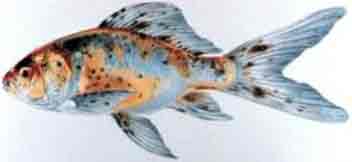
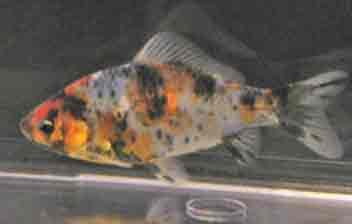
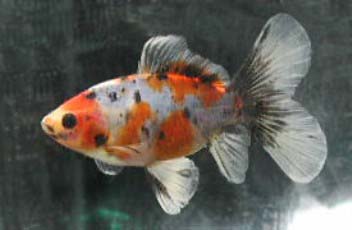
All three types of shubunkin have the calico colors, but each type has a different tail configuration.
All types, especially the London type, are recommended as a beginner fish.
All types, especially the London type, are recommended as a beginner fish.
The bluish coloration depends on a partial absence of demelanizing genes. All goldfish have the greenish black color of the wild form when young, but they soon demelanize, losing the black pigment to reveal the adult coloration.
Shubunkin is usually kept in ponds, but you can keep them in an aquarium as well as long as you can enough space. They can grow very large and an adult shubunkin needs at least 30-40 gallons of water, while a juvenile requires around 15 gallons.
Their environment should provide them with heavily planted places as well as open areas for swimming.
Regardless of whether you keep your shubunkin in an aquarium or a pond, it is inadvisable to keep them with slower swimming fish such as Telescope Goldfish or Bubble Eye Goldfish. The slower fishes might starve since the shubunkin will eat all the food before they have a chance to. A Koi is a much more suitable companion for a shubunkin.
Their environment should provide them with heavily planted places as well as open areas for swimming.
Regardless of whether you keep your shubunkin in an aquarium or a pond, it is inadvisable to keep them with slower swimming fish such as Telescope Goldfish or Bubble Eye Goldfish. The slower fishes might starve since the shubunkin will eat all the food before they have a chance to. A Koi is a much more suitable companion for a shubunkin.
Like other hardy goldfish and koi, shubunkins can be as easy or as difficult as you want them to be. They are easy to care for, and almost all are pretty.
However, finding that perfect fish that combines a perfect body and tail with bright striking coloration can be a life-long challenge.
However, finding that perfect fish that combines a perfect body and tail with bright striking coloration can be a life-long challenge.
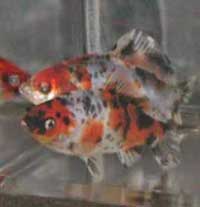
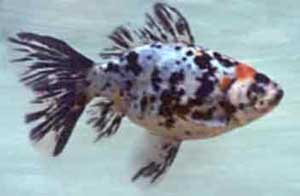
end of page
Copyright 2007 - 2010 by Pond and Garden Nursery - All Rights Reserved Contact: info@pondandgardennursery.com





(707)
792 - 9141
792 - 9141
In Sonoma County, beautiful northern California - 6225 Stony Point Rd - corner hwy 116 and Stony Point, Cotati, 94931
| Home | About Us | Location and Hours | Koi | Pond Services | Pond Supplies | Water Plants | Pond Dwellers | Dwarf Conifers | Hostas | Japanese Maples | Other Plants | Trees | Garden Sculpture | Garden Goodies | Pondsai | Contact Us
Serving Sonoma County for 15 years !
New Shipment!
Shubunkin
They are sometimes also called speckled, harlequin, calico goldfish, or coronation fish.
Blue is considered the most desirable color, though all are beautiful
